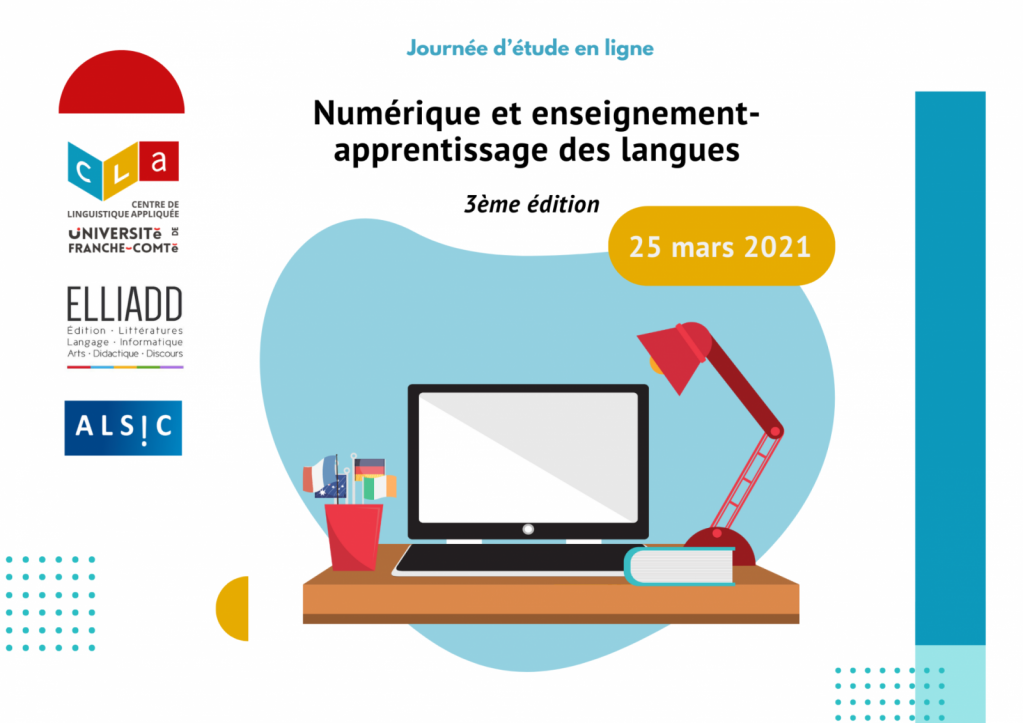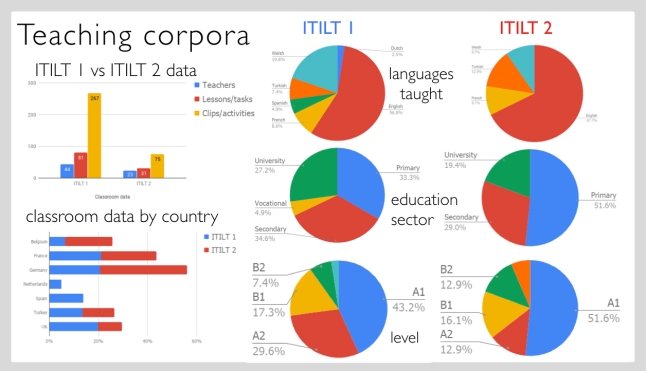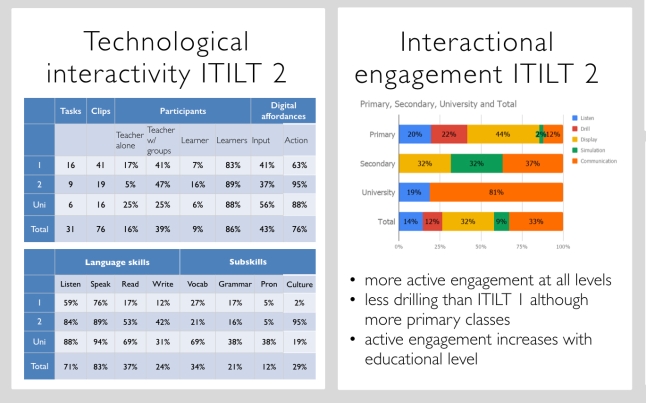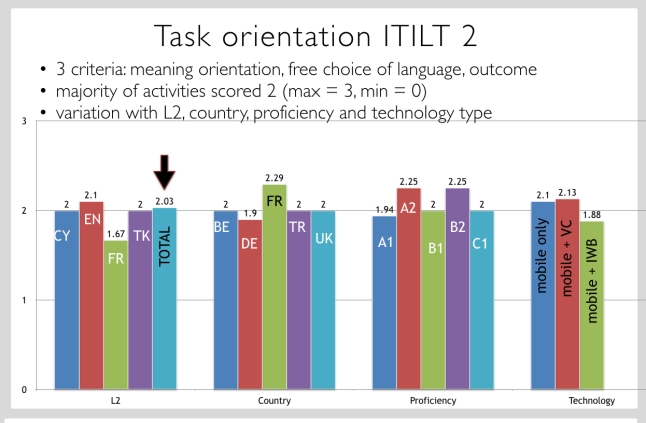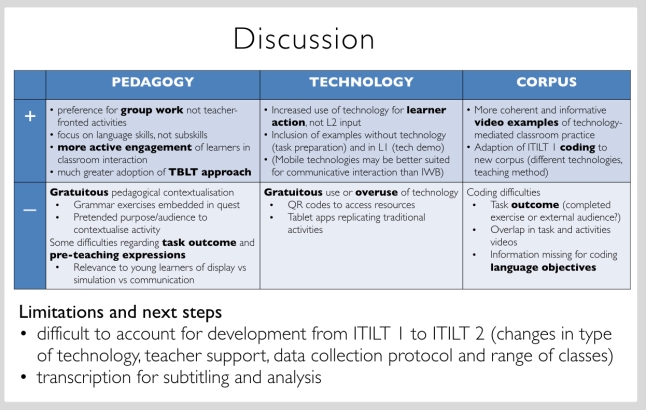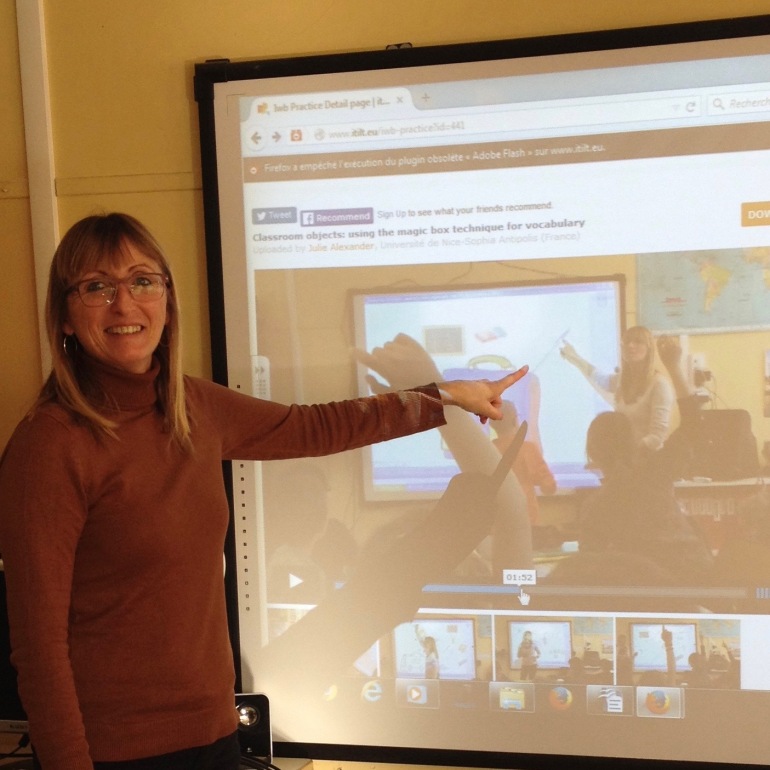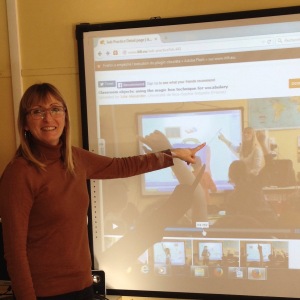Analysing target language interaction in IWB-mediated activities: from drills to tasks in state secondary EFL classes
Shona Whyte, Université Nice Sophia Antipolis, France
Euline Cutrim Schmid, Pädagogische Hochschule Schwäbisch Gmünd, Germany
Gary Beauchamp, Cardiff Metropolitan University, UK
Increased access to interactive technologies such as the interactive whiteboard (IWB) together with a methodological shift towards constructivist pedagogies are changing many classrooms and prompting research into effects on teaching and learning (Avvisati, 2013; Higgins, Beauchamp & Miller, 2007). Studies of IWB use in second language classrooms in European school and university settings suggest an often cautious approach to this new tool: the IWB is generally integrated into existing practice rather than acting as a catalyst for pedagogical transformation. Teachers tend to use a limited range of IWB tools and features for closely circumscribed teaching objectives, and generally follow personal pedagogical goals rather than adopting the communicative language teaching (CLT) and task-based language teaching (TBLT) approaches which currently underpin official programmes (Cutrim Schmid & Whyte, 2012; Whyte et al., 2013). A recent study of TBLT with the IWB using questionnaire, video, and interview data from 9 French EFL teachers found that transformation towards task-oriented teaching was associated with teachers with high IWB fluency and particular pedagogical engagement (Whyte & Alexander, in press).
The present study extends this line of research in an investigation of teacher and learner interaction using video recorded lessons with eleven state school teachers in France and Germany. In addition to primary classroom data, participants’ views were gathered via learner focus-group interviews and semi-structured video-stimulated teacher interviews, as part of a wider multilingual European research project on IWB-supported FL teaching. This analysis led to the development of a framework for classifying interaction, which includes CLT and TBLT criteria. The framework includes four levels of interaction, from the most basic level of drilling, through activities where teachers invite learner to display knowledge, more contextualised simulation activities, and finally to genuinely communicative tasks. The classification system includes the dimensions of focus on form/meaning, level of contextualisation and authenticity of tasks, and teacher/learner control.
The study allows for the correlation of differing levels of interaction with IWB use, participant characteristics, and teachers’ IWB experience, describing and explaining the level of interactivity and task-orientation of IWB-supported language teaching and learning in classes at different proficiency levels and across teachers with varying IWB and language teaching experience.
- Avvisati, F., Hennessey, S., Kozma, R., & Vincent-Lancrin, S. (2013). Review of the Italian Strategy for Digital Schools. OECD Education Working Papers, No. 90, OECD Publishing.
- Aldrich, F., Rogers, Y., & Scaife, M. (1998). Getting to grips with ‘interactivity’: Helping teachers assess the educational value of CD-ROMs. British Journal of Educational Technology, 29(4), 321–332.
- Blyth, C. (2010). Foreign language teaching methods: Speaking. http://coerll.utexas.edu/methods/modules/speaking/01/jigsaw.php
- Bygate, M., Skehan, P and Swain, M. (Eds.) (2001), Researching pedagogical tasks: second language learning, teaching, and assessment. London: Pearson.
- Glover, D., Miller, D., Averis, D., & Door, V. (2007). The evolution of an effective pedagogy for teachers using the interactive whiteboard in mathematics and modern languages: an empirical analysis from the secondary sector. Learning, Media and Technology, 32, 5–20.
- Gray, C, Pilkington, R, Hagger-Vaughan, L and Tomkins, SA. (2007). Integrating ICT into classroom practice in modern foreign language teaching in England: making room for teachers’ voices. European Journal of Teacher Education, 30 (4), 407-429
- Gray, C. (2010). Meeting Teachers’ Real Needs: New Tools in the Secondary Modern Foreign Languages Classroom. In Thomas, M. & Cutrim Schmid, E. (Eds.), Interactive Whiteboards for Education: Theory, Research and Practice. Hershey, New York: Information Science Reference, 69-85.
- Hennessy, S. & L. London (2013). Learning from International Experiences with Interactive Whiteboards: The Role of Professional Development in Integrating the Technology. OECD Education Working Papers, No. 89, OECD Publishing. http://dx.doi.org/10.1787/5k49chbsnmls-en
- Jewitt, C., Moss, G., & Cardini, A. (2007), Pace, Interactivity and Multimodality in Teachers’ Design of Texts for Interactive Whiteboards in the Secondary School Classroom. Learning, Media and Technology 32 (3), 303-317.
- Long, M. (1996). The role of the linguistic environment in second language acquisition. In Ritchie, W. C. & Bhatia, T. (Eds.), Handbook of Second Language Acquisition. New York: Academic Press.
Plowman L. (1996). Designing interactive media for schools: a review based on contextual observation. Information Design Journal 8 (3),258-266.
- Savignon, S. J. (2007). Beyond communicative language teaching: What’s ahead?. Journal of Pragmatics, 39(1), 207-220.
- Somekh, B., Haldane, M., Jones, K., Lewin, C., Steadman, S., Scrimshaw, P., Woodrow, D. (2007). Evaluation of the Primary Schools Whiteboard Expansion Project – summary report. (P. a. L. Centre for ICT, Trans.): Manchester Metropolitan University.
Ongoing research on IWB-mediated (language) instruction
Teaching languages with technology
How teachers use the IWB for language teaching, including the design and implementation of materials and activities.
Cutrim Schmid, E. (2009). The Pedagogical Potential of Interactive Whiteboards 2.0. In Thomas, M. (Ed) The Handbook of Research on Web 2.0 and Second Language Learning. IGI Global, USA.
Cutrim Schmid, E. (2008). Interactive Whiteboards and the Normalisation of CALL. In de Cassia, Rita; Morriott, Veiga; Torres, Patricia Luipon (Ed.): Handbook of Research on E-Learning Methodologies for Language Acquisition. IGI Global, USA.
Cutrim Schmid, E. (2006). Investigating the Use of Interactive Whiteboard Technology in the Language Classroom through the Lens of a Critical Theory of Technology. Computer Assisted Language Learning, 19 (1), 47-62.
Cutrim Schmid, E. & van Hazebrouck, Sanderin (2012). Material Development and Task Design for the Interactive Whiteboard in the Foreign Language Classroom. In Biebighäuser, K., Zibelius, M. & Schmidt, T. (Eds.) Aufgaben 2.0 – Konzepte, Materialien und Methoden für das Fremdsprachenlehren und -lernen mit digitalen Medien. Tübingen: Narr.
Sailer, H., Cutrim Schmid, E.. & Koenraad, T. (2014). The IWB in the CLIL classroom: using visuals to foster active learning with young beginners. In Cutrim Schmid, E., & Whyte, S. (Eds.) Teaching languages with technology: communicative approaches to interactive whiteboard use. A resource book for teacher development. London: Bloomsbury.
Whyte, S., & Alexander, J. (2014). Implementing tasks with interactive technologies in classroom CALL: towards a developmental framework. Canadian Journal of Learning and Technology, 40 (1), 1-26.
Whyte, S., Beauchamp, G., & Alexander, J. (2014). Researching interactive whiteboard use from primary school to university settings across Europe: an analytical framework for foreign language teaching. University of Wales Journal of Education, 17, 30-52.
Whyte, S., Beauchamp, G., & Hillier, E. (2012). Perceptions of the IWB for second language teaching and learning: the iTILT project. In L. Bradley & S. Thouësny (Eds.), CALL: Using, Learning, Knowing, EUROCALL Conference, Gothenburg, Sweden, 22-25 August 2012, Proceedings (pp. 320-6). doi: 10.14705/rpnet.2012.000074
Whyte, S., & Cutrim Schmid, E. (in press). A task-based approach to video communication with the IWB: a French-German primary EFL class exchange. In Cutrim Schmid, E., & Whyte, S. (Eds.). Teaching languages with technology: communicative approaches to interactive whiteboard use. A resource book for teacher development. London: Bloomsbury.
Whyte, S., Cutrim Schmid, E., & van Hazebrouck, S. (2011). Designing IWB Resources for Language Teaching: the iTILT Project. International Conference on ICT for Language Learning, 4th Edition. Simonelli Editore.
Teacher education research
Investigating technology-mediated teaching practice: a number of papers using semi-structured video-stimulated recall (VSR) interviews with teachers, and drawing on teacher efficacy (Bandura) frameworks.
Cutrim Schmid, E. (2011). Video-Stimulated Reflection as a Professional Development Tool in Interactive Whiteboard Research. ReCALL, 23 (3), 252-270.
Cutrim Schmid, E. & Whyte, S. (2012). Interactive Whiteboards in School Settings: Teacher Responses to Socio-constructivist Hegemonies. Language Learning and Technology 16 (2), 65-86.
Hillier, E., Beauchamp, G., & Whyte, S. (2013). A study of self-efficacy in the use of interactive whiteboards across educational settings: a European perspective from the iTILT project. Educational Futures, 5 (2)
Jones, S., Tanner, H., Kennewell, S., Parkinson, J., Denny, H., Anthony, C., Beauchamp, G., Jones, B., Lewis, H., & Loughran, A. (2009). Using Video Stimulated Reflective Dialogue to support the development of ICT based pedagogy in Mathematics and Science, The Welsh Journal of Education, 14(2), 63-77
Whyte, S. (2011). Learning to teach with videoconferencing in primary foreign language classrooms. ReCALL 23(3), 271–293.
Language teacher education
Supporting language teachers in technology-mediated practice: case studies, collaborative action research, and research projects on IWB education for language teachers.
Cutrim Schmid, E. (2010). Developing competencies for using the interactive whiteboard to implement communicative language teaching in the English as a Foreign Language classroom. In Technology, Pedagogy and Education, 9 (2), 159-172.
Cutrim Schmid, E. & Schimmack, E. (2010). First Steps towards a Model of Interactive Whiteboard Training for Language Teachers. In Thomas, M. and Cutrim Schmid, E. (Eds) Interactive Whiteboards: Theory, Research and Practice. IGI Global, USA.
Cutrim Schmid, E., & Whyte, S. (Eds.) Teaching languages with technology: communicative approaches to interactive whiteboard use. A resource book for teacher development. Advances in Digital Language Learning and Teaching (Series editors: Michael Thomas, Mark Warschauer & Mark Peterson). Bloomsbury.
Cutrim Schmid, E. & Whyte, Shona (2014). Ongoing professional development in IWB mediated language teaching: evening up the odds. In Cutrim Schmid, E., & Whyte, S. (Eds.) Teaching languages with technology: communicative approaches to interactive whiteboard use. A resource book for teacher development. London: Bloomsbury.
Koenraad, A. L. M., Whyte, S., & Cutrim Schmid, E. (2013). iTILT and SmartVET: 2 EU Projects to Promote Effective Interactive Whiteboard Use in Language and Vocational Education. In L. Bradley & S. Thouësny (Eds.), 20 Years of EUROCALL: Learning from the Past, Looking to the Future. Proceedings of the 2013 EUROCALL Conference, Évora, Portugal (pp. 149-157). Dublin/Voillans: © Research-publishing.net. doi: 10.14705/rpnet.2013.000153
Whyte, S. (2013). Orchestrating learning in the language classroom: the IWB as digital dashboard. Babylonia, 2013(3), 55-61.
Whyte, S., Cutrim Schmid, E., van Hazebrouck, S., & Oberhofer, M. (2013). Open educational resources for CALL teacher education: the iTILT interactive whiteboard project. Computer Assisted Language Learning, 27 (2), 122-148 doi: 10.1080/09588221.2013.818558
General teaching with (IWB) technology
Beauchamp, G. (2011). Interactivity and ICT in the primary school: categories of learner interactions with and without ICT, Technology, Pedagogy and Education, 20(2), , 175–190 (DOI: 10.1080/1475939X.2011.588408)
Beauchamp, G. (2004). Teacher use of the interactive whiteboard (IWB) in primary schools – towards an effective transition framework, Technology, Pedagogy and Education Volume 13 (3), 327 – 348 .
Beauchamp, G. & Kennewell, S. (2013). Transition in pedagogical orchestration using the whiteboard, Education and Information technologies,18 (2), 179-191
Beauchamp, G., & Kennewell, S. (2010) ‘Interactivity in the classroom and its impact on learning’, Computers and Education. 54. pp.759-766.
Beauchamp, G. and Kennewell, S. (2008) ‘The influence of ICT on the interactivity of teaching’, Special Issue of the Education and Information Technologies, Vol.13, No. 4, pp305-315.
Beauchamp, G. & Parkinson, J. (2005). Beyond the ‘wow’ factor: Developing interactivity with the interactive whiteboard, School Science Review, 86(316), 97-103
Kennewell, S. & Beauchamp. G. (2007). The features of interactive whiteboards and their influence on learning, Learning, Media and Technology 32(3), pp227-241
Kennewell, S., Tanner, H., Beauchamp, G., Parkinson, J., Jones, S., Meiring, L., Norman, N., Morgan, A., Thomas, G. (2009) ‘Interactive Teaching and ICT’, The Welsh Journal of Education, 14(2), 29-44.
Kennewell, S., Tanner, H, Jones, S., & Beauchamp, G. (2008) Analysing the use of interactive technology to implement interactive teaching’ Journal of Computer Assisted Learning 24(1), 61-73.
Higgins, S., Beauchamp, G. & Miller, D. (2007). Reviewing the literature on interactive whiteboards’, Learning, Media and Technology 32(3), 213-225
Van Laer, S., Beauchamp, G. And Colpaert, J. (2012). Teacher use of the Interactive Whiteboards in Flemish Secondary Education – mapping against a transition framework, Education and Information Technologies. DOI 10.1007/s10639-012-9228-6
Second language acquisition and teaching
Research on the relationship between interactive technologies and second language acquisition.
Whyte, S. (2014). Theory and practice in second language teaching with interactive technologies. In Cutrim Schmid, E., & Whyte, S. (Eds.) Teaching languages with technology: communicative approaches to interactive whiteboard use. A resource book for teacher development. London: Bloomsbury.
Cutrim Schmid, E. (2009). Interactive Whiteboard Technology in the Language Classroom: exploring new pedagogical opportunities. Saarbruecken, Germany: VDM Verlag Dr. Mueller.
Cutrim Schmid, E. (2008). Facilitating Whole-Class Collaborative Learning in the English Language Classroom: the Potential of Interactive Whiteboard Technology. In Müller-Hartmann, A. & Schocker-v. Ditfurth, M. (Eds.). Aufgabenorientiertes Lernen und Lehren mit Medien: Ansätze, Erfahrungen, Perspektiven in der Fremdsprachendidaktik. Frankfurt/ Main u.a.: Peter Lang.
